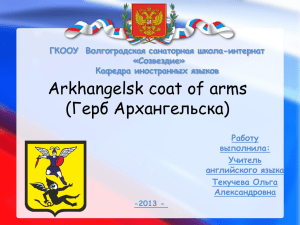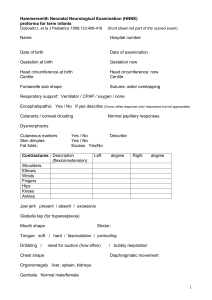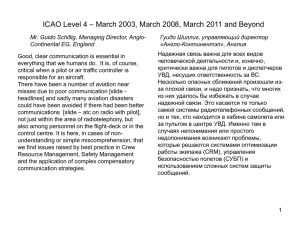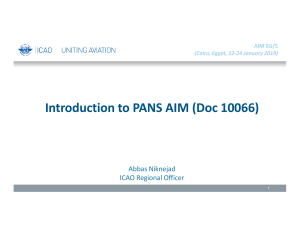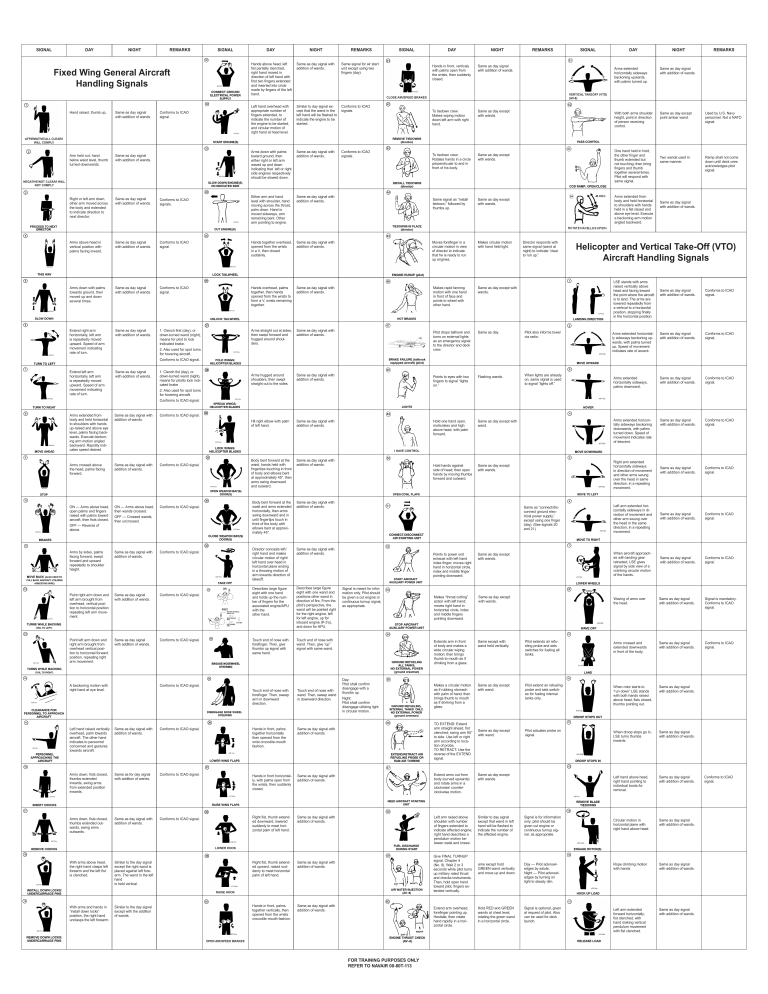
DAY SIGNAL NIGHT REMARKS SIGNAL Fixed Wing General Aircraft Handling Signals Hand raised, thumb up. Same as day signal with addition of wands. Conforms to ICAO signal. Arm held out, hand below waist level, thumb turned downwards. Same as day signal with addition of wands. Right or left arm down, other arm moved across the body and extended to indicate direction to next director. Same as day signal with addition of wands. Conforms to ICAO signals. Arms above head in vertical position with palms facing inward. Same as day signal with addition of wands. Conforms to ICAO signal. DAY NIGHT REMARKS Hands above head, left fist partially clenched, right hand moved in direction of left hand with first two fingers extended and inserted into circle made by fingers of the left hand. Same as day signal with addition of wands. Left hand overhead with appropriate number of fingers extended, to indicate the number of the engine to be started, and circular motion of right hand at head level. Similar to day signal except that the wand in the left hand will be flashed to indicate the engine to be started. Conforms to ICAO signals. Arms down with palms toward ground, then either right or left arm waved up and down indicating that left or right side engines respectively should be slowed down. Same as day signal with addition of wands. Conforms to ICAO signals. Either arm and hand level with shoulder, hand moving across the throat, palm down. Hand is moved sideways, arm remaining bent. Other arm pointing to engine. Same as day signal with addition of wands. Hands together overhead, opened from the wrists in a V, then closed suddenly. Same as day signal with addition of wands. SIGNAL Same signal for air start unit except using two fingers (day). DAY Hands in front, verticaly with palms open from the wrists, then suddenly closed. NIGHT REMARKS SIGNAL Same as day signal with addition of wands. DAY NIGHT REMARKS Arms extended horizontally sideways beckoning upwards, with palms turned up. Same as day signal with addition of wands. With both arms shoulder height, point in direction of person receiving control. Same as day except point amber wand. Used by U.S. Navy personnel. Not a NATO signal. Two wands used in same manner. Ramp shall not come down until deck crew acknowledges pilot signal. VERTICAL TAKEOFF (VTO) (AV-8) CLOSE AIR/SPEED BRAKES To tiedown crew: Makes wiping motion down left arm with right hand. Same as day except with wands. To tiedown crew: Rotates hands in a circle perpendicular to and in front of his body. Same as day except with wands. Same signal as “install tiedown,” followed by thumbs up. Same as day except with wands. Moves forefinger in a circular motion in view of director to indicate that he is ready to run up engines. Makes circular motion with hand held light. AFFIRMATIVE/ALL CLEAR/I WILL COMPLY NEGATIVE/NOT CLEAR/I WILL NOT COMPLY Arms down with palms towards ground, then moved up and down several times. Same as day signal with addition of wands. Conforms to ICAO signal. Hands overhead, palms together, then hands opened from the wrists to form a V, wrists remaining together. Same as day signal with addition of wands. Extend right arm horizontally, left arm is repeatedly moved upward. Speed of arm movement indicating rate of turn. Same as day signal with addition of wands. 1. Clench first (day), or down-turned wand (night), means for pilot to lock indicated brake. Arms straight out at sides, then swept forward and hugged around shoulders. Same as day signal with addition of wands. Arms hugged around shoulders, then swept straight out to the sides. Hit right elbow with palm of left hand. One hand held in hold, the other finger and thumb extended but not touching; then bring fingers and thumb together several times. Pilot will respond with same signal. Arms extended from body and held horizontal to shoulders with hands held in a fist raised and above eye level. Execute a beckoning arm motion angled backward. Director responds with same signal (wand at night) to indicate “clear to run up.” Same as day except with wands. Pilot drops tailhook and turns on external lights as an emergency signal to the director and deck crew. Same as day. Pilot also informs tower via radio. Same as day signal with addition of wands. Points to eyes with two fingers to signal “lights on.” Flashing wands. When lights are already on, same signal is used to signal “lights off.” Same as day signal with addition of wands. Hold one hand open, motionless and high above head, with palm forward. Same as day except with wand. Hold hands against side of head; then open hands by moving thumbs forward and outward. Same as day except with wands. 2. Also used for spot turns for hovering aircraft. Helicopter and Vertical Take-Off (VTO) Aircraft Handling Signals LSE stands with arms raised vertically above head and facing toward the point where the aircraft is to land. The arms are lowered repeatedly from a vertical to a horizontal position, stopping finally in the horizontal position. Makes rapid fanning motion with one hand in front of face and points to wheel with other hand. Same as day signal with addition of wands. Same as day signal with addition of wands. Conforms to ICAO signal. Same as day signal with addition of wands. Conforms to ICAO signal. Arms extended horizontally sideways, palms downward. Same as day signal with addition of wands. Conforms to ICAO signal. Arms extended horizontally sideways beckoning downwards, with palms turned down. Speed of movement indicates rate of descent. Same as day signal with addition of wands. Conforms to ICAO signal. Same as day signal with addition of wands. Conforms to ICAO signal. Same as day signal with addition of wands. Conforms to ICAO signal. Same as day signal with addition of wands. Conforms to ICAO signal. Arms extended horizontally sideways beckoning upwards, with palms turned up. Speed of movement indicates rate of ascent. Conforms to ICAO signal. Extend left arm horizontally, left arm is repeatedly moved upward. Speed of arm movement indicating rate of turn. Same as day signal with addition of wands. 1. Clench fist (day), or down-turned wand (night), means for pilotto lock indicated brake 2. Also used for spot turns for hovering aircraft. Conforms to ICAO signal. Arms extended from body and held horizontal to shoulders with hands up-raised and above eye level, palms facing backwards. Execute beckoning arm motion angled backward. Rapidity indicates speed desired Same as day signal with addition of wands. Arms crossed above the head, palms facing forward. Same as day signal with addition of wands. ON — Arms above head, open palms and fingers raised with palms toward aircraft, then fists closed. OFF — Reverse of above. Arms by sides, palms facing forward, swept forward and upward repeatedly to shoulder height. Conforms to ICAO signal. I HAVE CONTROL ON — Arms above head, then wands crossed. Conforms to ICAO signal. Conforms to ICAO signal. OFF — Crossed wands, then uncrossed. Same as day signal with addition of wands. Conforms to ICAO signal. Point right arm down and left arm brought from overhead, vertical position to horizontal position repeating left arm movement. Same as day signal with addition of wands. Conforms to ICAO signal. Point left arm down and right arm brought from overhead vertical position to horizontal forward position, repeating right arm movement. Same as day signal with addition of wands. Conforms to ICAO signal. A beckoning motion with right hand at eye level. Body bent forward at the waist, hands held with fingertips touching in front of body and elbows bent at approximately 45°, then arms swing downward and outward. Same as day signal with addition of wands. Body bent forward at the waist and arms extended horizontally, then arms swing downward and in until fingertips touch in front of the body with elbows bent at approximately 45°. Same as day signal with addition of wands. Director conceals left/ right hand and makes circular motion of right/ left hand over head in horizontal plane ending in a throwing motion of arm towards direction of takeoff. Same as day signal with addition of wands. Describes large figure eight with one hand and holds up the number of fingers for the associated engine/APU with the other hand. Describes large figure eight with one wand and positions other wand in direction of fire. From the pilot’s perspective, the wand will be pointed right for the right engine, left for left engine, up for inboard engine (P-3’s), and down for APU. Touch end of nose with forefinger. Then, give thumbs up signal with same hand. Touch end of nose with wand. Then, give “up” signal with same wand. Conforms to ICAO signal. Touch end of nose with forefinger. Then, sweep arm in downward direction. Touch end of nose with wand. Then, sweep wand in downward direction. Right arm extended horizontally sideways in direction of movement and other arms swung over the head in same direction, in a repeating movement. Same as “connect/disconnect ground electrical power supply,” except using one finger (day). (See signals 20 and 21.) Signal is meant for information only. Pilot should be given a cut engine or continuous turnup signal, as appropriate. Day: Pilot shall confirm disengage with a thumbs up. Night: Pilot shall confirm disengage utilizing light in circular motion. Left arm extended horizontally sideways in direction of movement and other arm swung over the head in the same direction, in a repeating movement. Points to power unit exhaust with left hand index finger; moves right hand in horizontal circle, index and middle finger pointing downward. Same as day except with wands. When aircraft approaches with landing gear retracted, LSE gives signal by side view of a cranking circular motion of the hands. Makes “throat cutting” action with left hand; moves right hand in horizontal circle, index and middle fingers pointing downward. Same as day except with wands. Waving of arms over the head. Same as day signal with addition of wands. Signal is mandatory. Conforms to ICAO signal. Extends arm in front of body and makes a wide circular wiping motion; then brings thumb to mouth as if drinking from a glass. Same except with wand held vertically. Pilot extends air refueling probe and sets switches for fueling all tanks. Arms crossed and extended downwards in front of the body. Same as day signal with addition of wands. Conforms to ICAO signal. Makes a circular motion as if rubbing stomach with palm of hand; then brings thumb to mouth as if drinking from a glass. Same as day except with wand. Pilot extend air refueling probe and sets switches for fueling internal tanks only. When rotor starts to “run down” LSE stands with both hands raised above head, fists closed, thumbs pointing out. Same as day signal with addition of wands. Same as day except with wand. Pilot actuates probe on signal. When droop stops go in, LSE turns thumbs inwards. Same as day signal with addition of wands. Left hand above head, right hand pointing to individual boots for removal. Same as day signal with addition of wands. Circular motion in horizontal plane with right hand above head. Same as day signal with addition of wands. TO EXTEND: Extend arm straight ahead, fist clenched; swing arm 90° to side. Use left or right arm according to location of probe. TO RETRACT: Use the reverse of the EXTEND signal. Left hand raised vertically overhead, palm towards aircraft. The other hand indicates to personnel concerned and gestures towards aircraft. Same as day signal with addition of wands. Conforms to ICAO signal. Hands in front, palms together horizontally then opened from the wrist crocodile-mouth fashion. Same as day signal with addition of wands. Arms down, fists closed, thumbs extended inwards, swing arms from extended position inwards. Same as for day signal with addition of wands. Conforms to ICAO signal. Hands in front horizontally, with palms open from the wrists, then suddenly closed. Same as day signal with addition of wands. Extend arms out from body (curved upwards) and rotate arms in a clockwise/ counterclockwise motion. Same as day except with wands. Arms down, fists closed, thumbs extended outwards, swing arms outwards. Same as day signal with addition of wands. Conforms to ICAO signal. Right fist, thumb extended downward, lowered suddenly to meet horizontal palm of left hand. Same as day signal with addition of wands. Left arm raised above shoulder with number of fingers extended to indicate affected engine; right hand describes a pendulum motion between waist and knees. Similar to day signal except that wand in left hand will be flashed to indicate the number of the affected engine. Signal is for information only; pilot should be given cut engine or continuous turnup signal, as appropriate. ame except hold GREEN wand vertically and move up and down. Day — Pilot acknowledges by salute. Night — Pilot acknowledges by turning on light to steady dim. Rope climbing motion with hands. Same as day signal with addition of wands. Hold RED and GREEN wands at chest level, rotating the green wand in a horizontal circle. Signal is optional, given at request of pilot. Also can be used for deck launch. Left arm extended forward horizontally, fist clenched, with hand making vertical pendulum movement with fist clenched. Same as day signal with addition of wands. LOWER HOOK With arms above head, the right hand clasps left forearm and the left fist is clenched. Similar to the day signal except the right wand is placed against left forearm. The wand in the left hand is held vertical. Right fist, thumb extended upward, raised suddenly to meet horizontal palm of left hand. Same as day signal with addition of wands. Hands in front, palms together vertically, then opened from the wrists crocodile-mouth fashion. Same as day signal with addition of wands. Give FINAL TURNUP signal. Chapter 4 (No. 9). Wait 2 or 3 seconds while pilot turns up military rated thrust and checks instruments. Then, hold open hand toward pilot, fingers extended vertically. RAISE HOOK With arms and hands in “install down locks” position, the right hand unclasps the left forearm. Similar to the day signal except with the addition of wands. Extend arm overhead, forefinger pointing up. Hesitate, then rotate hand rapidly in a horizontal circle. OPEN AIR/SPEED BRAKES FOR TRAINING PURPOSES ONLY REFER TO NAVAIR 00-80T-113 Conforms to ICAO signal.
